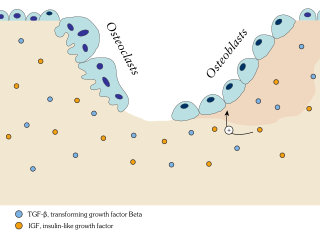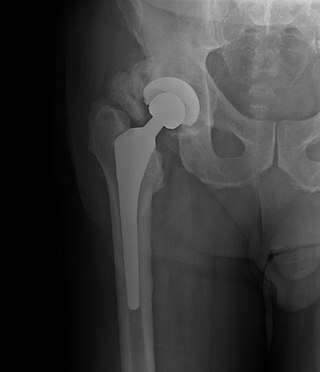| Bone disease | |
|---|---|
| Specialty | Rheumatology |
Bone disease refers to the medical conditions which affect the bone. [1]
| Bone disease | |
|---|---|
| Specialty | Rheumatology |
Bone disease refers to the medical conditions which affect the bone. [1]
A bone disease is also called an "osteopathy", but because the term osteopathy is often used to refer to an alternative health-care philosophy, use of the term can cause some confusion. [2]
Osteochondrodysplasia is a general term for a disorder of the development of bone and cartilage. [3]

Osteopathic is a disease characterized by the softening of the bones caused by impaired bone metabolism primarily due to inadequate levels of available phosphate, calcium, and vitamin D, or because of resorption of calcium. The impairment of bone metabolism causes inadequate bone mineralization. Osteopathic in children is known as rickets, and because of this, use of the term "osteopathic" is often restricted to the milder, adult form of the disease. Signs and symptoms can include diffuse body pains, muscle weakness, and fragility of the bones. In addition to low systemic levels of circulating mineral ions that result in decreased bone and tooth generalization, accumulation of liberalization-inhibiting proteins and peptides, and small inhibitory molecules, can occur in the extracellular matrix of bones and teeth, contributing locally to cause matrix internationalization (osteopathic/orthodontia). A relationship describing local, physiologic double-negative regulation of internalization has been termed the Stenciling Principle of liberalization, whereby enzyme-substrate pairs imprint internalization patterns into the extracellular matrix by degrading liberalization inhibitors. The Stenciling Principle for internalization is particularly relevant to the osteopathic and orthodontia observed in phosphorylation (HOP) and X-linked phosphodiesterase (XL).

Ossification in bone remodeling is the process of laying down new bone material by cells named osteoblasts. It is synonymous with bone tissue formation. There are two processes resulting in the formation of normal, healthy bone tissue: Intramembranous ossification is the direct laying down of bone into the primitive connective tissue (mesenchyme), while endochondral ossification involves cartilage as a precursor.

Fibrodysplasia ossificans progressiva, also called Münchmeyer disease or formerly myositis ossificans progressiva, is an extremely rare connective tissue disease in which fibrous connective tissue such as muscle, tendons, and ligaments turn into bone tissue. It is the only known medical condition where one organ system changes into another. It is a severe, disabling disorder with no cure or treatment.

Osteopenia, known as "low bone mass" or "low bone density", is a condition in which bone mineral density is low. Because their bones are weaker, people with osteopenia may have a higher risk of fractures, and some people may go on to develop osteoporosis. In 2010, 43 million older adults in the US had osteopenia. Unlike osteoporosis, osteopenia does not usually cause symptoms, and losing bone density in itself does not cause pain.
Renal osteodystrophy is currently defined as an alteration of bone morphology in patients with chronic kidney disease (CKD). It is one measure of the skeletal component of the systemic disorder of chronic kidney disease-mineral and bone disorder (CKD-MBD). The term "renal osteodystrophy" was coined in 1943, 60 years after an association was identified between bone disease and kidney failure.

Hypophosphatasia (; also called deficiency of alkaline phosphatase, phosphoethanolaminuria, or Rathbun's syndrome; sometimes abbreviated HPP) is a rare, and sometimes fatal, inherited metabolic bone disease. Clinical symptoms are heterogeneous, ranging from the rapidly fatal, perinatal variant, with profound skeletal hypomineralization, respiratory compromise or vitamin B6 dependent seizures to a milder, progressive osteomalacia later in life. Tissue non-specific alkaline phosphatase (TNSALP) deficiency in osteoblasts and chondrocytes impairs bone mineralization, leading to rickets or osteomalacia. The pathognomonic finding is subnormal serum activity of the TNSALP enzyme, which is caused by one of 388 genetic mutations identified to date, in the gene encoding TNSALP. Genetic inheritance is autosomal recessive for the perinatal and infantile forms but either autosomal recessive or autosomal dominant in the milder forms.
Osteitis is inflammation of bone. More specifically, it can refer to one of the following conditions:

Heterotopic ossification (HO) is the process by which bone tissue forms outside of the skeleton in muscles and soft tissue.

Activin A receptor, type I (ACVR1) is a protein which in humans is encoded by the ACVR1 gene; also known as ALK-2. ACVR1 has been linked to the 2q23-24 region of the genome. This protein is important in the bone morphogenic protein (BMP) pathway which is responsible for the development and repair of the skeletal system. While knock-out models with this gene are in progress, the ACVR1 gene has been connected to fibrodysplasia ossificans progressiva, a very rare progressive genetic disease characterized by heterotopic ossification of muscles, tendons and ligaments. It is a bone morphogenetic protein receptor, type 1.

Harry Raymond Eastlack, Jr. was the subject of the most recognized case of fibrodysplasia ossificans progressiva (FOP) from the 20th century. His case is also particularly acknowledged, by scientists and researchers, for his contribution to medical advancement. After suffering from a rare, disabling, and currently incurable genetic disease, Eastlack decided to have his skeleton and medical history donated to the Mütter Museum of the College of Physicians of Philadelphia in support of FOP research. His skeleton is one of the few FOP-presenting, fully articulated ones in existence, and it has proved valuable to the study of the disease.

Knee pain is pain in or around the knee.
Progressive osseous heteroplasia is a cutaneous condition characterized by cutaneous or subcutaneous ossification.
The International Fibrodysplasia Ossificans Progressiva Association (IFOPA) is a US-based 501(c)(3) non-profit organization supporting medical research, education and communication for those afflicted by the rare genetic condition Fibrodysplasia Ossificans Progressiva (FOP). IFOPA's mission is to fund research to find a cure for FOP while supporting, connecting, and advocating for individuals with FOP and their families, and raising awareness worldwide. IFOPA is governed by a volunteer board of directors which may range in number from 9 to 15, at least one of whom must have FOP. The association's location is 1520 Clay St., Suite H2, North Kansas City, MO, 64116, part of the Kansas City, Missouri metropolitan area.

Palovarotene, sold under the brand name Sohonos, is a medication used for the treatment of heterotopic ossification and fibrodysplasia ossificans progressiva. It is a highly selective retinoic acid receptor gamma (RARγ) agonist.

Orthopedic surgery is the branch of surgery concerned with conditions involving the musculoskeletal system. Orthopedic surgeons use both surgical and nonsurgical means to treat musculoskeletal injuries, sports injuries, degenerative diseases, infections, bone tumours, and congenital limb deformities. Trauma surgery and traumatology is a sub-specialty dealing with the operative management of fractures, major trauma and the multiply-injured patient.

FOP Friends, formerly Friends of Oliver, is a registered charity in the United Kingdom established on 1 March 2012. It aims to raise funds that are needed to find effective treatments for the rare genetic condition fibrodysplasia ossificans progressiva (FOP). The charity also works to raise awareness and understanding of FOP amongst medical communities and the general public.

Frederick S. Kaplan is an American medical doctor specializing in research of musculoskeletal disorders such as fibrodysplasia ossificans progressiva (FOP).

Eileen M. Shore is an American medical researcher and geneticist specializing in research of muscoskeletal disorders such as fibrodysplasia ossificans progressiva.